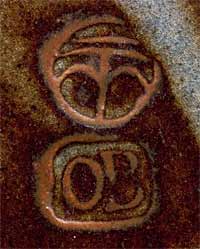



Michael OBrien (no apostrophe) was born in 1930. He was educated at Westminster School and trained as a painter at Farnham School of Art. On leaving the art school he became an art teacher and worked at a secondary school in Leicester.
He drifted into potting for two reasons; he felt that some of his more gifted pupils were better painters than he, and he became increasingly frustrated by the time taken in preparation before and cleaning up after painting.
He felt that the best available teacher of pottery was Michael Cardew, but Cardew was in Nigeria. At great expense, he went to Abuja to study under Cardew, but the Nigerian authorities would allow him to stay for only three months as a student. To circumvent this restriction he got a job as an art teacher at the secondary school in Abuja and stayed there for two years. When Cardew had to retire in 1965, the authorities asked OBrien to take over the running of the Pottery Training Centre, which he did for seven years.
On his return to England in 1972 he rejoined Michael Cardew at Wenford Bridge to carry on learning. When he left Wenford Bridge he worked at Wrecclesham (Farnham Pottery) and gained experience throwing standard pots in standard sizes.
In1979 he returned to Nigeria to take up a post teaching at the university. Before leaving England he telephoned to ask if there was anything they would like him to bring with him - he knew that certain commodities were not easy to get in Nigeria - and they asked him to bring some quartz. This made him resolve to teach both staff and students how to get their own materials; they had been importing materials that were relatively easy to obtain locally from Stoke on Trent! He wanted to increase the length of the pottery course from three to five years so that the students could learn to make their own equipment, but that plan did not come to fruition.
Michael's next project was to build a pottery with Danlami Aliyu at Maraba. This pottery is now run by Danlami's younger brother, Umara. Michael and Danlami went on to set up another pottery at Mineh, and this is still flourishing under the management of Danlami.
In 1999 yet another new pottery was started at Bwari, and the building was finished in May, 2000. The pottery, which was built on the principles of the Abuja Pottery, is now operating and it is expected that it will employ around twenty potters.
Michael constantly experiments with glazes to achieve the exact effect he requires, and keeps meticulous records, making pyramids of glaze test samples mounted on plywood boards, each one with details of the recipe, temperature and time inscribed on the back.
| Further Reading: | Nigerian Pottery in an African Context by Michael OBrien |

Michael Cardew moved from Winchcombe to Wenford Bridge on the edge of Bodmin Moor in Cornwall with his wife, Mariel, and his three young sons in June 1939. They bought the derelict Wenford Inn for £500 and started to convert it for use as a pottery.
Before the conversion was finished, war broke out, and after only two glaze firings at Wenford Cardew had to return to Winchcombe to help Ray Finch who had been badly affected by the conscription of both Charlie and Sid Tustin. He stayed there until June 1942. While he was at Winchcombe he was offered the position of Pottery Instructor at Achimota on the African Gold Coast. Money was tight and the £600 per annum that the job offered was too good to refuse. Cardew was to remain in Africa for the next six years, with only a brief return to England during the winter of 1944/1945.
In 1948 trouble was brewing in West Africa and Cardew's life was threatened. He returned to his wife, family and home in July of that year. He worked as a thrower in Surrey for six months and then resumed work at Wenford Bridge.
In 1950 Ivan McMeekin, an Australian potter joined as a partner, and ran the pottery when Cardew returned yet again to West Africa. McMeekin build a down-draught kiln and produced stoneware at Wenford Bridge until 1954. Cardew spent two months of each year at Wenford Bridge during his fifteen year stay in Nigeria, but after McMeekin returned to Australia the pottery was unused until Cardew's retirement from his African post in 1965.
Cardew then potted at Wenford Bridge when lecture tours and demonstrations permitted until his death in 1983. In 1971 he was joined by his eldest son, Seth Cardew, and in the following years many fine potters including Svend Bayer, Michael OBrien and Danlami Aliyu spent time there as students.
Wenford Bridge Pottery closed in late 2004 when Seth moved to Spain
Further Reading: |
Pioneer Pottery by Michael Cardew |
| You can buy this book on line | |
| Pioneer Pottery by Michael Cardew | |